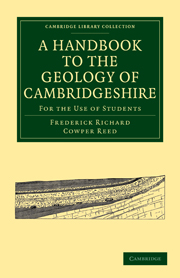RECENT ALLUVIUM, ETC.
Published online by Cambridge University Press: 05 July 2011
Summary
Bordering the present rivers and their tributaries are strips of flat marshy land of variable width composed of alluvial deposits of sandy loam and mud of recent origin and comparatively slight geological importance.
Black peaty earth with land and freshwater shells is often found immediately beneath the surface soil on the low level land, marking the site of old marshes and swamps, many of which have only been drained within the last century or so.
Blown sand derived from the weathering of the sandy Boulder Clay covers large tracts to the north-east of Newmarket around Mildenhall, and pebbles polished by the attrition of the grains of sand are found in that neighbourhood. Rain-wash occurs here and there on the slopes and at the foot of the Chalk hills.
‘Warp’ and ‘trail’ are terms which have been employed to denote the two kinds of subsoil found in this area.
Beneath the vegetable would lie the soil and subsoil, which are composed partly of the debris of the subjacent undisturbed rock and partly of material from a distance. The upper part of this surface covering has been called the ‘warp,’ to be distinguished from the tidal warp of the Fens, and the lower portion, which occurs in furrows and troughs, has been called the ‘trail.’ The latter is devoid of organic remains and consists usually of a marly clay with stones and patches of gravel.
- Type
- Chapter
- Information
- A Handbook to the Geology of CambridgeshireFor the Use of Students, pp. 235 - 236Publisher: Cambridge University PressPrint publication year: 2009First published in: 1897



